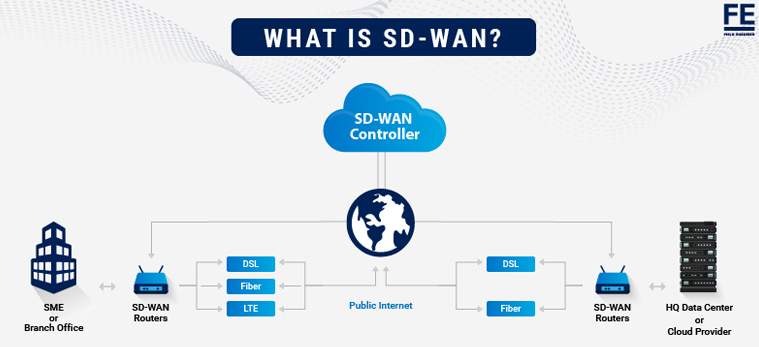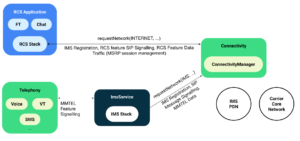SD-WAN brings more speed, agility, and security to your business. It makes delivering new services more accessible and accelerates the growth of existing business functions.
Traditional WAN designs backhaul branch traffic to data centers using closed networks and restrictive class-of-service assignments. More distributed sites, remote workers, and cloud service adoption increase bandwidth demands.
Enhanced Security
Security is one of the top concerns for many small and medium businesses. With remote workers and a larger attack surface, companies must ensure they are adequately protected.
The right SD-WAN offers integrated security features that protect sensitive data and help prevent cyberattacks. These include encryption, next-gen firewalls, and threat intelligence capabilities.
Another benefit of an SD-WAN is the ability to route traffic over multiple connections, including broadband and local Internet lines. This can help lower WAN operating costs and reduce reliance on expensive leased MPLS circuits.
In the end, this can improve application performance and reduce latency. Plus, it can provide a more seamless on-ramp to the cloud.
In addition to reducing bandwidth, SD-WAN can improve network efficiency by using more innovative traffic routing, load sharing, centralized controls, and visibility. These advantages can result in better productivity, customer satisfaction, and revenue growth for your business.
Scalability
SD-WAN architecture provides scalability for small and medium businesses, making it easier to grow your network without adding new hardware. It is also less expensive than MPLS, reducing ongoing operational costs and capital expenditures while blurring the hard edges of traditional networking to enable more flexible applications.
As a result, your business can be more responsive to changes in demand and market trends. You can deploy new branches quickly and add Internet circuits to connect remote locations as you grow.
In addition, if one of your Internet connections fails, SD-WAN can automatically fail over to another. This means that no interruptions to business-critical communications will happen.
Your WAN can be configured to prioritize traffic that needs the fastest connection to ensure that business applications continue to work efficiently. For example, if you have electronically protected health information that must be shared in real-time for patient care, you can designate this traffic to an encrypted private link.
Additionally, application optimization helps your users access cloud-based applications and services that require high bandwidth. This improves the experience of your employees and customers, so they can remain productive while on the go or away from their office.
Better Performance
Using an SD-WAN architecture, businesses can connect users with the necessary application resources via any connectivity method – broadband Internet, LTE, or MPLS. They can also adapt their connections as they grow, adding or removing branches or offices.
In today’s world, the most important networks for companies are those that can handle the increased bandwidth and performance demands of modern business applications. Fortunately, a software-defined vast area network (SD-WAN) architecture can deliver better performance to users across your business network.
This improves employee productivity, customer satisfaction, and, ultimately, your profitability. You can rely on your SD-WAN to deliver the best performance without sacrificing security and data privacy.
Another key advantage of an optimal SD-WAN architecture is scalability – guaranteeing service continuity as your business grows. Unlike traditional network infrastructures that require costly upgrades to maintain service, you can easily add new locations or change connections with an SD-WAN solution.
Businesses can also benefit from a centralized control system that manages traffic and offloads noncritical business applications to lower costs. It can also detect and respond to issues before they impact critical applications.
Flexibility
As a result of the increased adoption of cloud-based applications for real-time business, many small businesses are looking to implement SD-WAN. This is a great way to connect all your users and devices, regardless of location, so that they can access their applications and files securely.
Aside from ensuring a secure connection, these solutions also help to boost application performance. This is especially useful for applications sensitive to latency and packet loss, such as VoIP calls.
Another critical factor is that these systems are flexible and can be scaled as needed. This will ensure that you can get the best possible performance from your network as the needs of your company change.
Centralized Management
As businesses expand, they need to keep up with the demands of remote employees and customers. They also want to provide reliable cloud-based applications and updated data in real-time.
This requires a scalable, dynamic network infrastructure with higher performance and scalability to accommodate growth. This is where an optimal SD-WAN comes in handy.
An SD-WAN architecture efficiently manages your network through a single console. This allows for consistent networking policies across your entire organization.
Another advantage is that it helps you to prioritize mission-critical traffic based on current network conditions and other parameters. This ensures critical business traffic is always routed to the best possible connection.
In addition, an SD-WAN offers an entire mesh topology to help prevent network outages. This ensures that your company can continue to operate even if one or more connections fail. This will keep your business running smoothly and effectively while saving you money on bandwidth costs.






More Stories
SCPM Client vs. Traditional Methods: Revolutionizing Supply Chain Performance
How to Effectively Remove ChocoEukor from Your Android Device
Is Companion Device Manager Spyware? 10 Shocking Truths Revealed